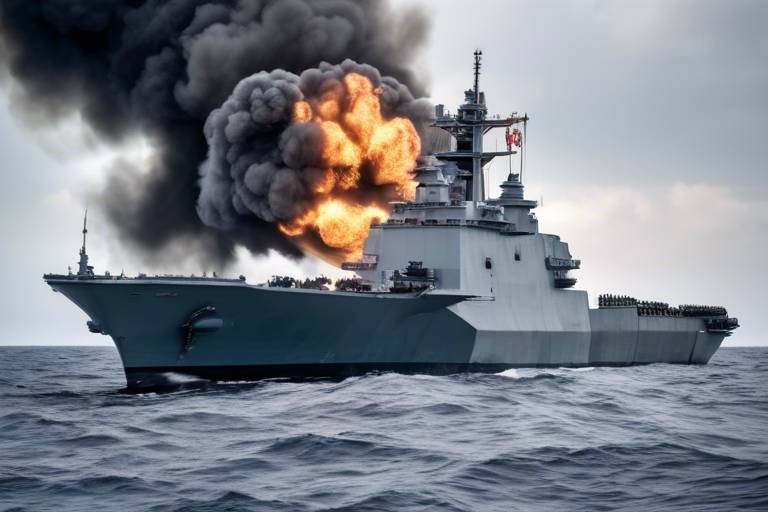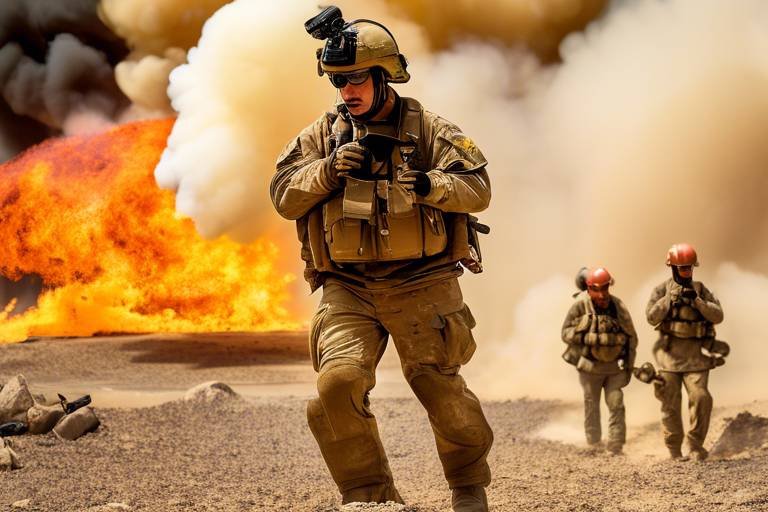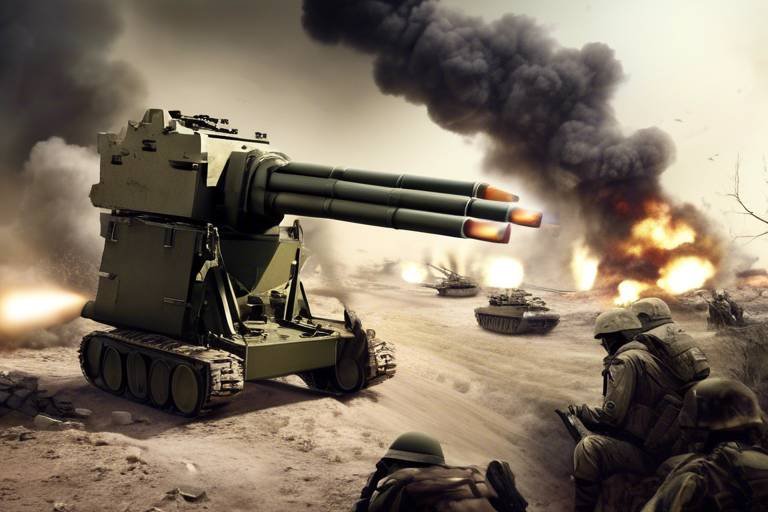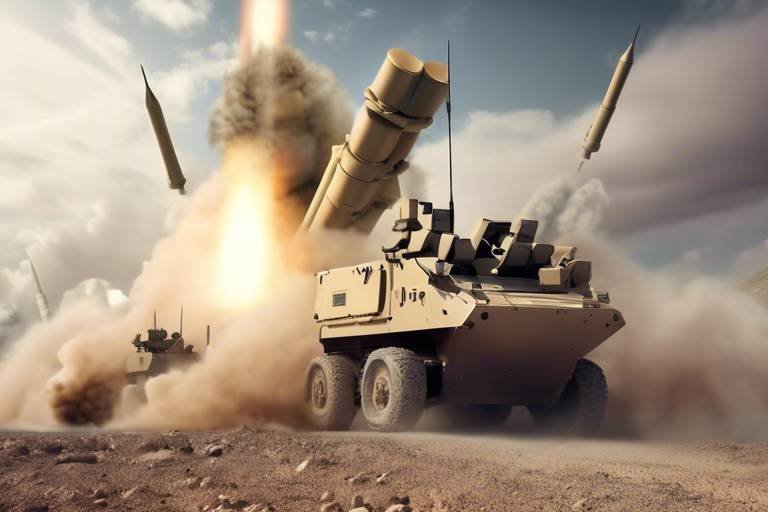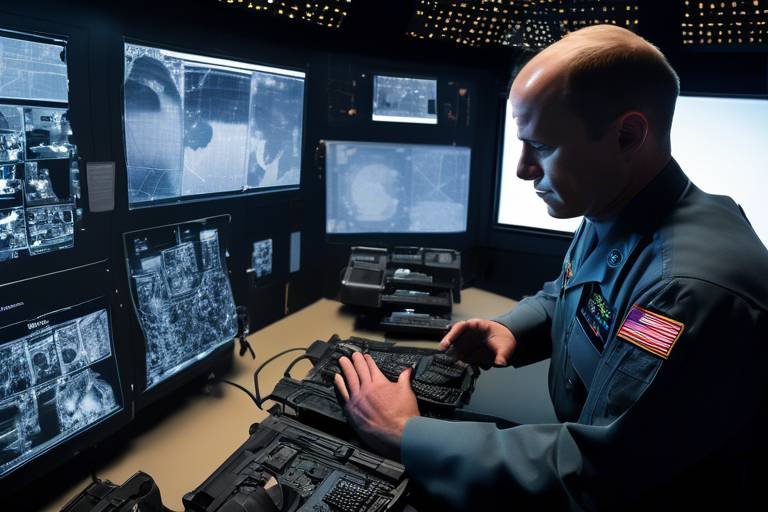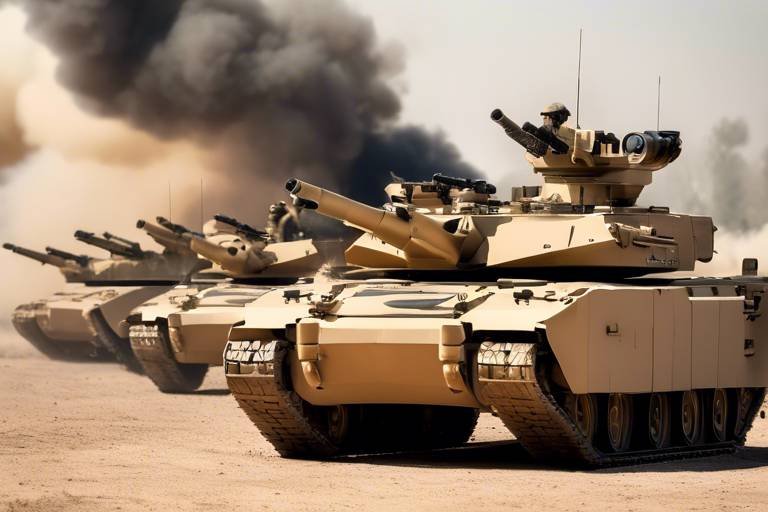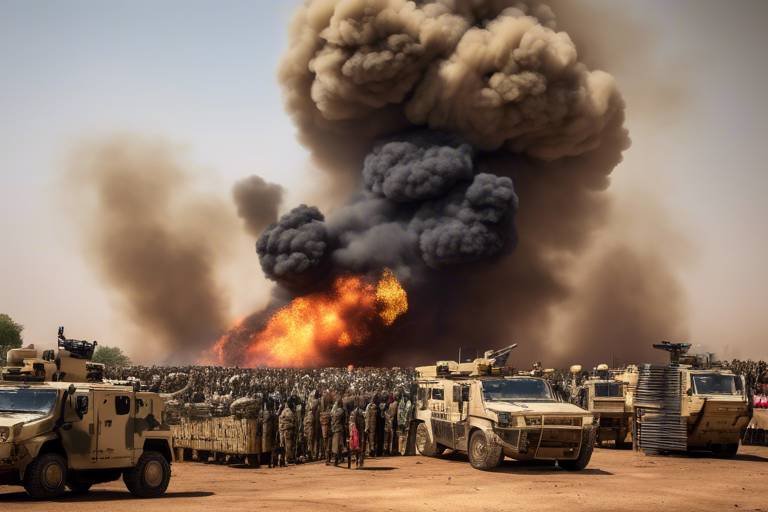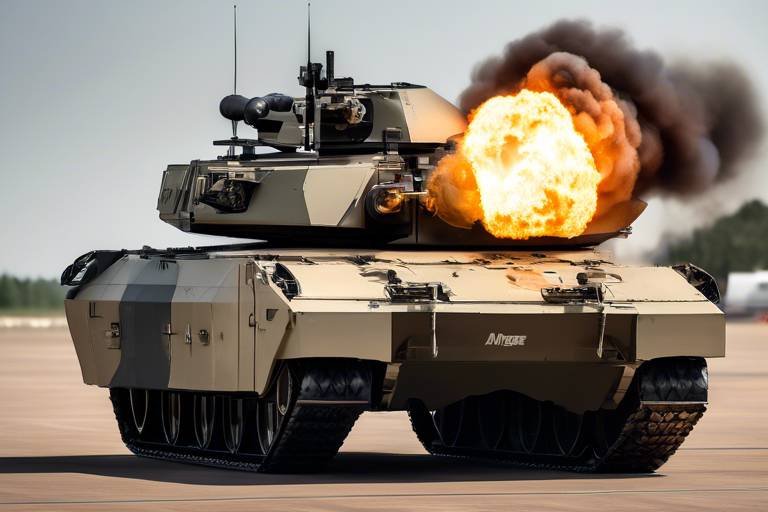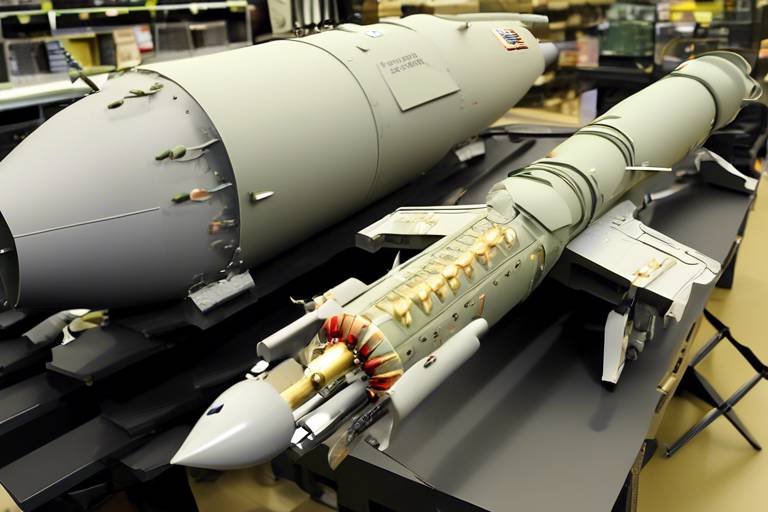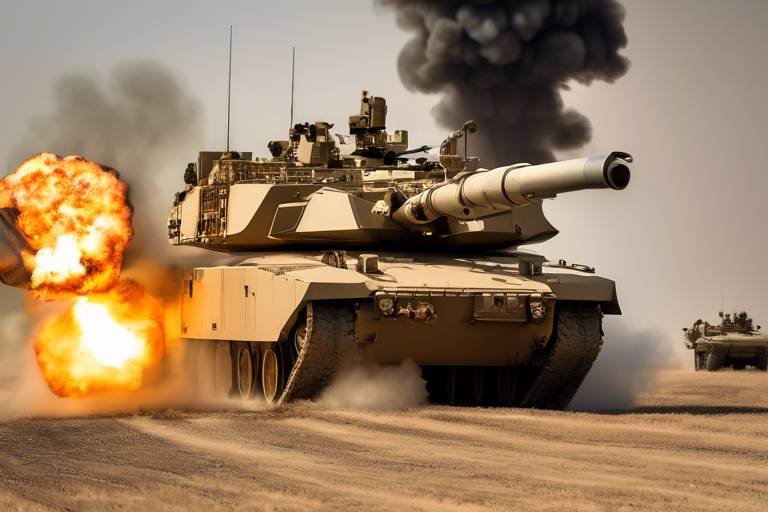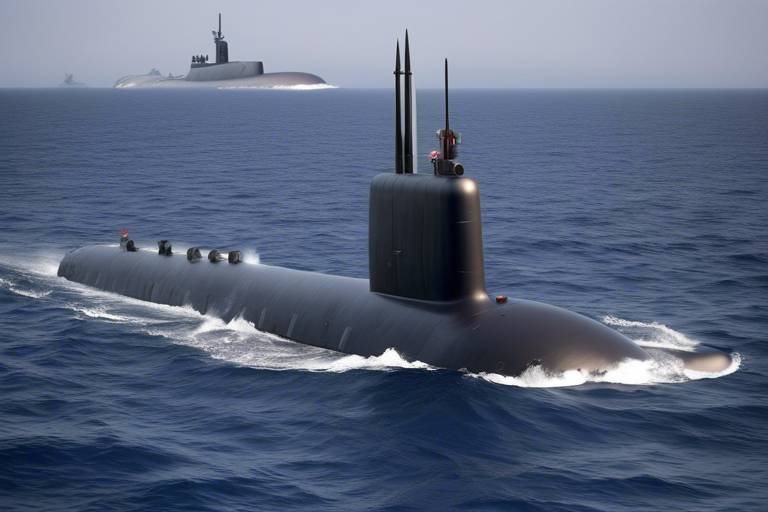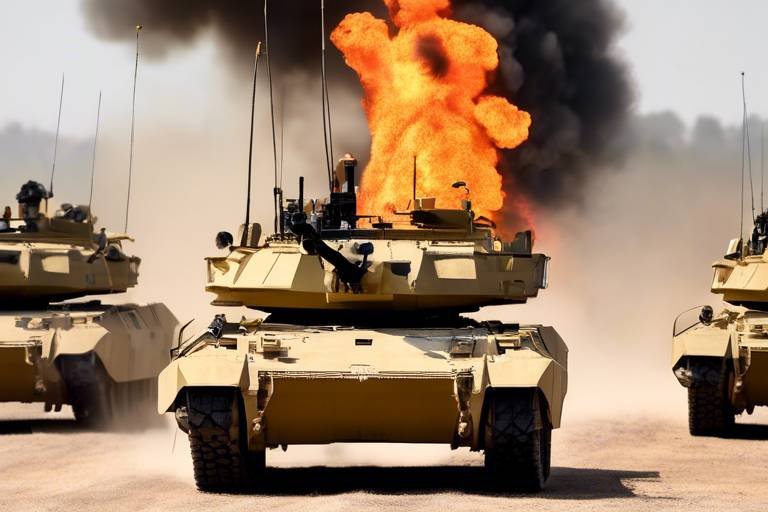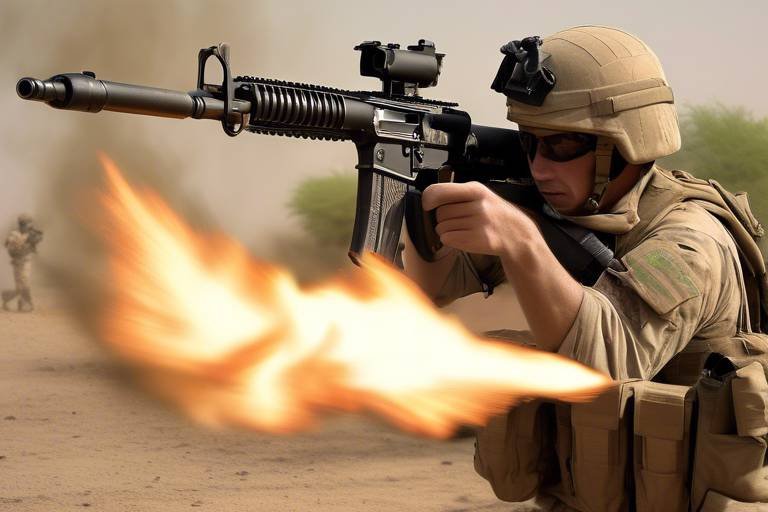Understanding the Role of Firepower in Maritime Operations
When we think about naval warfare, the image that often comes to mind is one of massive ships, roaring cannons, and missiles soaring through the sky. But what does firepower really mean in the context of maritime operations? Firepower isn't just about the sheer strength of a ship's arsenal; it's about strategy, effectiveness, and the ability to adapt to rapidly changing situations on the high seas. In modern naval warfare, understanding the role of firepower is crucial for achieving mission success and maintaining dominance over maritime territories.
Firepower serves as the backbone of naval strategy. It influences critical decisions regarding fleet deployment, the rules of engagement, and the overall objectives of a mission. Imagine being a chess player, where every piece on the board represents a different asset in your navy. The way you deploy your pieces—your firepower—determines your ability to control the game. Similarly, in maritime operations, the effective use of firepower can dictate the outcome of engagements and the safety of your forces.
In today’s complex geopolitical landscape, the significance of firepower extends beyond traditional notions of combat. It’s about leveraging technology, integrating various systems, and ensuring that naval forces can respond to threats swiftly and decisively. The modern battlefield is not just a physical space; it’s a multifaceted environment where air, sea, and even cyber capabilities converge. This convergence emphasizes the need for a robust understanding of how firepower operates within this intricate web.
Moreover, firepower is not a one-size-fits-all concept. Different types of firepower—such as naval guns, missiles, and air support—each play unique roles in maritime operations. For instance, while naval guns provide immediate support during surface engagements, missile systems allow for long-range strikes that can alter the tactical landscape. This diversity in firepower means that naval commanders must be adept at utilizing a range of assets to achieve their objectives.
As we delve deeper into the topic, we will explore how modern advancements in technology have transformed traditional firepower. From enhanced accuracy of naval guns to the strategic deployment of unmanned aerial vehicles (UAVs), the evolution of firepower is a testament to human ingenuity and the relentless pursuit of maritime superiority. Understanding these dynamics is essential for anyone interested in the future of naval operations.
- What is the primary role of firepower in naval strategy? Firepower is crucial for shaping strategies, influencing fleet deployment, and determining engagement rules to achieve mission success.
- How do different types of firepower contribute to naval effectiveness? Various assets like naval guns, missiles, and air support serve distinct roles, enhancing overall operational effectiveness in diverse combat scenarios.
- What are the challenges associated with deploying firepower? Challenges include logistical constraints, adhering to rules of engagement, and ensuring coordination among different naval assets.
The Importance of Firepower in Naval Strategy
When we think about naval strategy, the first thing that often comes to mind is the vastness of the ocean and the ships that navigate it. However, behind the scenes, firepower plays a pivotal role in shaping the very essence of these strategies. It’s not just about having a fleet; it’s about how effectively that fleet can project its strength. Firepower influences decisions on fleet deployment, engagement rules, and overall mission objectives, which are crucial for ensuring dominance at sea. Imagine a chess game where each piece has its own unique ability to strike; that’s how firepower functions within naval operations.
In essence, firepower serves as the backbone of naval strategy. It dictates how commanders plan their operations, often determining the success or failure of missions. For example, a navy equipped with advanced missile systems can engage targets from a distance, altering the dynamics of naval engagements. This capability not only enhances offensive strategies but also serves as a deterrent against potential adversaries. The mere presence of robust firepower can lead to a strategic advantage, making it an indispensable element of naval warfare.
Moreover, the integration of firepower into naval strategy is not a one-size-fits-all approach. Different scenarios require different types of firepower. For instance, during a conflict, naval commanders must assess whether to deploy naval guns for close engagements or utilize missile systems for long-range strikes. Each choice carries its own set of implications for both tactics and outcomes. This flexibility allows naval forces to adapt to the ever-changing landscape of maritime warfare.
Another critical aspect is the coordination between various branches of the military. Firepower in naval strategy is not limited to ships alone; it extends to air support, submarines, and ground forces. The effective integration of these elements can create a multi-dimensional approach to warfare. For example, a carrier strike group can combine air and naval firepower to conduct complex operations, showcasing how firepower transcends individual platforms and becomes a unified force.
In summary, understanding the importance of firepower in naval strategy is essential for grasping the complexities of modern warfare. It shapes tactical decisions, influences fleet deployments, and ultimately determines mission success. As we dive deeper into the various types of firepower available in maritime operations, it becomes clear that each component plays a unique yet interconnected role in achieving naval superiority.
- What is firepower in the context of naval warfare?
Firepower refers to the military capability to deliver effective strikes against targets using various weapons systems, including guns, missiles, and aircraft. - Why is firepower important in naval strategy?
Firepower is crucial for shaping naval strategies as it influences decisions on fleet deployment, engagement rules, and mission objectives, ensuring dominance at sea. - How do different types of firepower impact naval operations?
Different types of firepower, such as naval guns and missile systems, serve distinct roles and are selected based on the specific tactical needs of a mission. - What role does air power play in conjunction with naval firepower?
Air power enhances naval operations by providing reconnaissance, strike capabilities, and situational awareness, thus complementing the firepower of naval vessels.
Types of Firepower in Maritime Operations
When we talk about the types of firepower in maritime operations, we're diving into a complex world where various systems work together to ensure naval dominance. Each type of firepower has its unique characteristics and is designed to fulfill specific roles during combat scenarios. Think of it as a well-orchestrated symphony, where each instrument contributes to the overall harmony of naval warfare.
At the heart of maritime firepower are three primary categories: naval guns, missile systems, and air power. Each of these categories plays a pivotal role in shaping the effectiveness of a navy's operational capabilities. Let's break down these elements and see how they contribute to mission success.
Naval gun systems are often considered the backbone of surface engagements. They provide direct fire support to ground forces and help maintain control over maritime territories. Imagine a naval gun as the heavy artillery of the sea, capable of delivering powerful strikes against enemy vessels and land targets alike. These systems are not just limited to large battleships; they can also be found on smaller vessels, ensuring versatility across different classes of ships.
Recent technological advancements have taken naval guns to a whole new level. With improved accuracy and range, modern naval guns can engage targets more effectively than ever before. For instance, the introduction of automated loading systems and advanced targeting technologies allows for rapid firing and precise targeting. This evolution means that naval forces can respond quickly to threats, making them a formidable presence in any maritime conflict.
In the context of amphibious operations, naval guns are absolutely vital. They offer crucial fire support to landing forces, suppressing enemy defenses and ensuring safe landings for troops and equipment. Picture a scenario where marines are storming a beach; naval guns can provide cover fire, neutralizing threats before the troops even set foot on land. This capability not only enhances the chances of a successful landing but also minimizes casualties among ground forces.
Now, let’s shift our focus to missile systems, which have revolutionized naval warfare. These systems enable long-range strikes against enemy vessels and land targets, significantly altering the dynamics of engagement. Unlike naval guns, which are primarily effective at shorter ranges, missiles can be launched from great distances, allowing naval forces to strike first and strike hard. This capability is akin to having a sniper in a firefight—able to take out high-value targets from a safe distance.
Missile systems can be categorized into different types, including surface-to-surface, surface-to-air, and anti-ship missiles. Each type serves a distinct purpose, ensuring that naval forces can adapt to various combat scenarios. For example, anti-ship missiles are specifically designed to target enemy vessels, while surface-to-air missiles protect naval assets from aerial threats.
The integration of air power into maritime operations enhances the effectiveness of naval firepower. Carrier-based aircraft and drones complement traditional naval assets, providing situational awareness and striking capabilities that are crucial in modern engagements. Just as a quarterback directs a football play, air power coordinates with naval forces to execute complex strategies across vast maritime domains.
In conclusion, understanding the types of firepower available in maritime operations is essential for grasping the complexities of modern naval warfare. From the heavy-hitting naval guns to the precision of missile systems and the strategic advantage of air power, each element plays a vital role in ensuring mission success on the high seas.
- What is the primary role of naval guns in maritime operations? Naval guns provide direct fire support to ground forces and help maintain control over maritime territories.
- How have missile systems changed naval warfare? Missile systems allow for long-range strikes, altering engagement dynamics and enabling naval forces to strike first.
- Why is air power important in maritime operations? Air power enhances situational awareness and striking capabilities, complementing traditional naval assets.
Naval Gun Systems
Naval gun systems are the backbone of maritime firepower, playing a pivotal role in surface engagements and providing essential support to ground forces. Imagine a massive ship, its deck bristling with powerful artillery, ready to unleash a torrent of fire upon enemy positions. This image encapsulates the essence of naval guns in modern warfare. These systems are not just about raw firepower; they represent a strategic advantage that can dictate the outcome of naval operations.
One of the remarkable features of naval guns is their versatility. They can engage a variety of targets, from enemy ships to land installations, and even provide support for amphibious assaults. Their ability to deliver precise strikes over considerable distances makes them invaluable in maintaining control over maritime territories. The integration of advanced targeting systems and modern ammunition types has further enhanced their effectiveness, allowing naval forces to engage threats with pinpoint accuracy.
In recent years, technological advancements have significantly improved the capabilities of naval gun systems. For instance, the introduction of automated loading systems and advanced fire control technology has increased the rate of fire and reduced the time required to engage targets. This evolution has transformed naval guns from mere support weapons into formidable instruments of sea power. The table below highlights some of the key features of modern naval gun systems:
| Feature | Description |
|---|---|
| Range | Modern naval guns can engage targets at distances exceeding 100 nautical miles. |
| Accuracy | Advanced targeting systems allow for precision strikes, reducing collateral damage. |
| Rate of Fire | Some systems can fire up to 20 rounds per minute, ensuring sustained fire support. |
| Versatility | Can engage surface, air, and land targets, providing multi-domain support. |
Furthermore, naval guns play a crucial role in amphibious operations. When forces are preparing to land on hostile shores, naval gunfire can suppress enemy defenses, allowing troops to safely disembark and establish a foothold. The psychological impact of naval gunfire cannot be understated; the mere presence of these guns can deter enemy forces and provide assurance to landing troops. In essence, naval gun systems are not just weapons; they are a symbol of naval power and a critical element in the broader strategy of maritime operations.
In conclusion, the significance of naval gun systems in maritime operations cannot be overstated. They provide a robust means of delivering firepower, ensuring that naval forces can effectively engage a variety of threats while supporting ground operations. As technology continues to advance, we can expect these systems to evolve, further enhancing their role in modern naval warfare.
- What are naval gun systems used for? Naval gun systems are primarily used for engaging surface ships, providing fire support for land forces, and conducting anti-air operations.
- How have naval guns evolved over time? Recent advancements include improved accuracy, automated loading systems, and enhanced targeting capabilities, making them more effective in modern combat scenarios.
- Why are naval guns important in amphibious operations? They provide essential fire support to suppress enemy defenses, ensuring the safe landing of troops and equipment on hostile shores.
Modern Advancements in Naval Guns
In the ever-evolving landscape of naval warfare, are nothing short of revolutionary. Gone are the days when naval engagements relied solely on brute force and sheer firepower; today, precision, range, and technology define the battlefield. With the integration of advanced targeting systems, automated loading mechanisms, and cutting-edge materials, naval guns have transformed into sophisticated instruments of warfare.
One of the most significant advancements is the incorporation of computerized fire control systems. These systems enhance accuracy by calculating variables such as wind speed, humidity, and target movement. Imagine a sniper with a high-tech scope—this is the level of precision modern naval guns achieve. This technological leap allows naval forces to engage targets at extended ranges with remarkable accuracy, minimizing collateral damage and maximizing operational effectiveness.
Additionally, the development of electromagnetic railguns is set to redefine naval artillery. Unlike traditional guns that rely on chemical propellants, railguns use electromagnetic forces to launch projectiles at incredible speeds, exceeding Mach 6. This not only increases the range but also reduces the need for explosive warheads, making these weapons safer and more efficient. The implications for naval strategy are profound, as these weapons can engage threats from a distance, keeping naval vessels out of harm's way.
Moreover, advancements in ammunition technology have led to the creation of guided munitions. These projectiles can adjust their trajectory mid-flight, allowing for precision strikes on moving targets. For instance, the Long Range Land Attack Projectile (LRLAP) is designed to hit targets over 100 nautical miles away, providing naval forces with a significant tactical advantage. The ability to strike with such precision and from such distances changes the dynamics of naval engagements, allowing for more strategic planning and execution.
Furthermore, modern naval guns are increasingly being integrated into network-centric warfare systems. This integration allows for real-time data sharing among various naval assets, enhancing situational awareness and coordination. Imagine a fleet where every ship and aircraft is interconnected, sharing vital information instantaneously. This capability not only improves targeting but also allows for rapid response to emerging threats, ensuring that naval forces can adapt to changing circumstances on the battlefield.
In summary, the advancements in naval guns are paving the way for a new era of maritime warfare. With improved accuracy, range, and integration into broader military systems, these weapons are becoming indispensable in modern naval operations. As technology continues to evolve, we can expect even more innovative developments that will further enhance the effectiveness of naval firepower.
- What are the key advancements in modern naval guns? Modern naval guns have seen improvements in accuracy, range, and the integration of advanced targeting systems and automated loading mechanisms.
- How do electromagnetic railguns differ from traditional naval guns? Railguns use electromagnetic forces to launch projectiles at much higher speeds compared to traditional guns that use chemical propellants.
- What role do guided munitions play in naval warfare? Guided munitions allow for precision strikes on moving targets, significantly enhancing the effectiveness of naval operations.
- How does network-centric warfare benefit naval operations? Network-centric warfare improves situational awareness and coordination among naval assets, enabling rapid response to threats.
Role of Naval Guns in Amphibious Operations
Naval guns play a critical role in amphibious operations, acting as the first line of defense and support for landing forces. Imagine a scene where troops are poised to land on hostile shores, and the sound of naval artillery echoes in the distance, signaling that they have the firepower needed to suppress enemy defenses. This is where naval guns come into play, providing essential fire support that can dictate the success of an operation.
During an amphibious assault, naval guns are deployed to execute a variety of tasks, including:
- Suppressing Enemy Fire: Before troops make landfall, naval guns target enemy positions to minimize their ability to return fire. This suppression is crucial for ensuring the safety of landing forces.
- Providing Direct Fire Support: Once troops are on the ground, naval guns continue to offer direct support, engaging targets that threaten the landing forces.
- Establishing Maritime Control: By maintaining a presence and exerting firepower, naval guns help secure the area around the landing zone, preventing enemy reinforcements from entering the battlefield.
In modern warfare, the effectiveness of naval guns has been enhanced by technological advancements. These advancements allow for improved accuracy and range, enabling naval forces to strike targets with precision from greater distances. For instance, the integration of advanced targeting systems means that naval guns can now engage moving targets more effectively, a game-changer in dynamic combat environments.
Moreover, the coordination between naval gunfire and ground forces is vital. Effective communication ensures that naval gunners understand the needs of the troops on the ground. This synergy not only maximizes the impact of fire support but also helps in minimizing collateral damage, which is a significant concern in today’s combat scenarios.
However, the role of naval guns in amphibious operations is not without challenges. The logistics of coordinating naval fire support with ground operations require meticulous planning. Commanders must ensure that naval assets are in the right position and that their munitions are ready for use when needed. This level of coordination is akin to conducting a symphony, where every instrument must play in harmony to create a successful outcome.
In conclusion, the role of naval guns in amphibious operations cannot be overstated. They provide a decisive advantage in establishing and maintaining control over the battlefield, ensuring that troops can land safely and effectively. As military technology continues to evolve, the capabilities of naval guns will likely expand further, solidifying their importance in modern naval warfare.
- What is the primary function of naval guns in amphibious operations?
Naval guns primarily provide fire support to suppress enemy defenses and protect landing forces during amphibious assaults. - How have technological advancements improved naval gun effectiveness?
Recent advancements have enhanced accuracy, range, and targeting capabilities, allowing for more precise engagements in dynamic combat environments. - Why is coordination between naval forces and ground troops essential?
Effective coordination ensures that naval gunfire supports ground operations without causing collateral damage, maximizing operational effectiveness.
Missile Systems and Their Impact
Missile systems have revolutionized the landscape of naval warfare, introducing a new era of long-range engagements and precision strikes. Unlike traditional naval combat, where ships would close in for direct confrontations, today's missile systems allow for engagement from vast distances, fundamentally altering the dynamics of naval strategy. Imagine a chess game where the pieces can move across the board in a single leap—this is how missile systems change the rules of engagement at sea.
Modern missile technology encompasses a variety of systems, each designed for specific roles within naval operations. These include anti-ship missiles, land-attack missiles, and cruise missiles, each serving unique purposes in combat scenarios. For instance, anti-ship missiles are primarily designed to target enemy vessels, while land-attack missiles can strike strategic land targets from the sea, showcasing the versatility of missile systems in achieving mission objectives.
One of the most significant impacts of missile systems is their ability to project power over great distances. This capability not only enhances the striking range of naval forces but also serves as a deterrent against potential aggressors. When adversaries know that a navy can launch a missile strike from hundreds of miles away, it changes their calculations and often leads to a more cautious approach in their maritime operations.
Furthermore, the integration of missile systems with advanced targeting and guidance technologies has dramatically improved the accuracy of strikes. This precision reduces collateral damage and increases the likelihood of achieving tactical objectives, making missile systems a preferred choice in modern naval engagements. For example, systems like the Tomahawk cruise missile have become synonymous with precision strikes, capable of hitting targets with remarkable accuracy.
However, the deployment of missile systems is not without its challenges. The complexity of coordinating missile launches with other naval assets requires meticulous planning and communication. Additionally, the rules of engagement dictate when and how these systems can be used, often requiring commanders to balance operational effectiveness with legal and ethical considerations.
To further illustrate the impact of missile systems, consider the following table, which outlines key characteristics of various missile types:
| Missile Type | Range | Target Type | Guidance System |
|---|---|---|---|
| Anti-Ship Missile | Up to 300 km | Naval Vessels | Active Radar/Infrared |
| Cruise Missile | Up to 1,500 km | Land Targets | GPS/INS |
| Ballistic Missile | Varies (up to 5,500 km) | Strategic Targets | Inertial/Terminal Guidance |
In conclusion, missile systems are a cornerstone of modern naval warfare. Their ability to engage targets at long ranges, combined with advanced technologies, enhances the effectiveness of naval operations and contributes to overall mission success. As naval strategies continue to evolve, missile systems will undoubtedly play an increasingly pivotal role in shaping the future of maritime conflict.
- What are the main types of missile systems used in naval warfare? The main types include anti-ship missiles, cruise missiles, and ballistic missiles, each serving distinct roles.
- How do missile systems enhance naval strategy? They allow for long-range engagements, providing a tactical advantage and acting as a deterrent against adversaries.
- What challenges exist in deploying missile systems? Challenges include logistical coordination, adherence to rules of engagement, and the need for precise targeting to minimize collateral damage.
Integration of Air Power in Maritime Operations
The integration of air power in maritime operations is not just an enhancement; it's a game-changer. Imagine a chessboard where every piece has the potential to strike from multiple angles—this is how air power operates within the naval domain. By combining the strengths of carrier-based aircraft and drones, modern navies are able to achieve unparalleled situational awareness and striking capabilities.
Carrier strike groups, often considered the backbone of naval air power, consist of a variety of aircraft that can engage in multiple roles. These groups are designed to project power far beyond the horizon, allowing for rapid response to emerging threats. The synergy between naval firepower and air support creates a formidable force that can dominate maritime engagements. For instance, when a carrier group is deployed, it can conduct air strikes, provide reconnaissance, and support ground operations—all while being protected by its own naval assets.
Moreover, the use of Unmanned Aerial Vehicles (UAVs) has become increasingly prevalent in maritime operations. UAVs are not merely tools for surveillance; they are essential for real-time intelligence gathering and targeting. These aerial platforms can loiter over vast areas, providing commanders with crucial data that enhances decision-making processes during engagements. Think of UAVs as the eyes in the sky, relaying vital information that can turn the tide of battle.
However, integrating air power into maritime operations is not without its challenges. Coordination between air and naval forces is paramount. Miscommunication can lead to catastrophic errors, especially in high-stakes environments. Therefore, training and exercises that simulate joint operations are essential for ensuring that both air and naval units operate seamlessly together.
In summary, the integration of air power into maritime operations amplifies the effectiveness of naval forces, enabling them to respond swiftly and decisively to threats. It creates a multi-dimensional battlefield where the combination of air and sea capabilities can outmaneuver and outgun adversaries. As technology continues to evolve, the role of air power in maritime warfare will only become more critical, reshaping strategies and tactics in ways we can only begin to imagine.
- What is the role of air power in naval operations?
Air power enhances naval operations by providing reconnaissance, strike capabilities, and real-time intelligence, allowing for more effective engagement of threats. - How do carrier strike groups operate?
Carrier strike groups combine various aircraft to project power at sea, conducting air strikes and providing support for naval and ground forces. - What are the benefits of using UAVs in maritime operations?
UAVs offer real-time surveillance and targeting information, improving situational awareness and decision-making during engagements. - What challenges are faced in integrating air and naval forces?
Challenges include ensuring effective communication and coordination between air and naval units to avoid miscommunication and operational errors.
Carrier Strike Groups
Carrier strike groups (CSGs) are the backbone of modern naval power, acting as floating fortresses that project military might across vast oceans. Imagine a mini-city at sea, equipped with everything from advanced aircraft to robust naval vessels, all working in concert to achieve strategic objectives. These groups typically consist of an aircraft carrier, guided-missile destroyers, submarines, and support ships. Together, they form a formidable force capable of executing a variety of missions, from air defense to anti-submarine warfare.
What makes CSGs so effective? It’s their ability to combine different types of firepower into a single cohesive unit. The aircraft carrier serves as the centerpiece, launching a variety of aircraft that can engage targets on land and at sea. These aircraft can be fighter jets, bombers, or reconnaissance planes, each adding a layer of capability to the group. For instance, while fighter jets provide air superiority, bombers can deliver precision strikes on enemy installations, and reconnaissance planes gather crucial intelligence. This multi-dimensional approach ensures that CSGs can adapt to different combat scenarios, making them a versatile asset in any naval operation.
Moreover, CSGs enhance maritime operations by providing a mobile base for air operations, which is crucial when conducting missions far from home ports. With their ability to operate in international waters, these groups can respond quickly to emerging threats, conduct humanitarian missions, or support allied nations. The presence of a CSG can deter potential aggressors simply by being in the region, showcasing a nation’s commitment to maintaining maritime security.
However, operating a CSG is not without its challenges. Logistical support is essential to keep the group functioning effectively. The ships must be stocked with fuel, ammunition, and supplies, and this requires meticulous planning and coordination. Additionally, the integration of various platforms within the group demands seamless communication and operational synchronization. When everything aligns, the result is a powerful force capable of achieving mission success.
In summary, carrier strike groups represent the pinnacle of naval warfare capabilities. They blend various forms of firepower and operational flexibility, allowing for a wide range of missions in diverse maritime environments. As global tensions rise and naval engagements become more complex, the role of CSGs in maintaining security and projecting power will undoubtedly remain crucial.
- What is a Carrier Strike Group? A carrier strike group is a naval formation centered around an aircraft carrier, supported by destroyers, submarines, and other vessels, designed to project power and conduct various military operations.
- What types of aircraft are typically found in a CSG? A CSG usually includes fighter jets, bombers, reconnaissance aircraft, and helicopters, each serving different operational roles.
- How does a CSG contribute to maritime security? By maintaining a presence in international waters, a CSG can deter potential threats, conduct humanitarian missions, and support allied nations, thereby enhancing regional stability.
Unmanned Aerial Vehicles (UAVs)
Unmanned Aerial Vehicles, or UAVs, have revolutionized the landscape of maritime operations. These remarkable machines, often referred to as drones, serve a multitude of purposes that enhance naval capabilities. Picture this: a silent observer soaring high above the ocean, gathering intelligence, and relaying critical information back to command centers in real-time. This is the power of UAVs in action, and it’s changing the way naval forces conduct operations.
One of the most significant advantages of UAVs is their ability to perform reconnaissance missions without putting pilots at risk. This capability allows naval commanders to gain a comprehensive understanding of the battlefield without the inherent dangers of manned aircraft. Furthermore, UAVs can cover vast areas quickly, providing situational awareness that is crucial for making informed decisions. Imagine having eyes in the sky that can detect enemy movements or track maritime traffic, giving you the upper hand in any engagement.
Moreover, UAVs are not just about observation; they also play a vital role in targeting and precision strikes. Equipped with advanced sensors and weaponry, these aerial vehicles can engage targets with pinpoint accuracy. This capability minimizes collateral damage and enhances operational effectiveness. For instance, when a naval fleet is confronted with a hostile vessel, a UAV can identify the target, assess the threat level, and even coordinate an attack—all while remaining out of harm's way.
As technology continues to evolve, the integration of UAVs into naval operations is becoming more sophisticated. They are now equipped with AI-driven systems that allow for autonomous decision-making during missions. This means that UAVs can not only gather data but also analyze it and respond to threats without waiting for instructions from human operators. The implications of this are profound, as it allows for faster reaction times and more agile responses to dynamic maritime situations.
However, the deployment of UAVs is not without its challenges. Issues such as communication and data security must be addressed to ensure that these systems operate effectively in contested environments. Additionally, the reliance on UAVs raises questions about the ethical implications of using drones for surveillance and strikes. As we embrace this technology, it’s essential to strike a balance between operational advantages and the moral responsibilities that come with them.
In summary, UAVs are transforming maritime operations by providing enhanced reconnaissance, targeting capabilities, and autonomous decision-making. As we look to the future, the role of these unmanned systems will only continue to grow, making them an indispensable part of modern naval warfare.
- What are UAVs used for in maritime operations?
UAVs are primarily used for reconnaissance, surveillance, and targeting in maritime operations, providing real-time intelligence and enhancing decision-making processes. - How do UAVs enhance naval capabilities?
UAVs enhance naval capabilities by offering a risk-free means of gathering intelligence, executing precision strikes, and improving situational awareness. - What are the challenges of using UAVs in naval operations?
Challenges include communication issues, data security concerns, and ethical considerations regarding surveillance and engagement rules.
Challenges in Firepower Deployment
Deploying firepower in maritime operations is not as straightforward as one might think. While the sheer might of naval guns and missile systems can be awe-inspiring, the reality is that effective deployment is fraught with challenges. One of the primary hurdles is logistical constraints. Imagine trying to orchestrate a grand symphony where every instrument needs to be perfectly in tune; similarly, naval operations require meticulous planning to ensure that all necessary resources, including ammunition and support systems, are available when needed. This means that naval commanders must consider supply routes, storage facilities, and the availability of spare parts, all while navigating the unpredictable nature of maritime environments.
Another significant challenge is the rules of engagement. These rules can often feel like a double-edged sword. On one hand, they are essential for maintaining legal and ethical standards during military operations. On the other hand, they can restrict a commander’s ability to respond swiftly to threats. Understanding when and how to deploy firepower while adhering to these rules is critical. For instance, a naval commander may find themselves in a situation where they have the firepower to neutralize a threat but are constrained by engagement protocols that prioritize civilian safety or diplomatic considerations.
Moreover, the integration of various naval assets adds another layer of complexity. When deploying firepower, different branches of the military—such as surface ships, submarines, and aircraft—must work in concert. This requires seamless communication and coordination, akin to a well-choreographed dance. If one element falters, it can jeopardize the entire operation. For example, if a carrier strike group is unable to communicate effectively with its support vessels, the risk of friendly fire incidents increases, which could lead to catastrophic consequences.
In addition to these challenges, the unpredictable nature of maritime environments, including weather conditions and sea states, can significantly affect firepower deployment. Imagine trying to hit a moving target while riding a roller coaster; that's how difficult it can be to maintain accuracy in adverse conditions. High waves, strong winds, and fog can all impede visibility and affect the trajectory of projectiles, making it essential for naval forces to adapt quickly and efficiently to changing circumstances.
Finally, the rapid pace of technological advancements in warfare means that naval forces must continuously evolve their strategies and tactics. The introduction of new systems can render existing firepower obsolete if not integrated properly. This creates a pressing need for ongoing training and adaptation among personnel to ensure they are equipped to handle the latest technologies. Failure to keep up with these advancements can lead to a significant disadvantage, especially when facing adversaries who are quick to adopt cutting-edge solutions.
In conclusion, while firepower is undeniably a cornerstone of maritime operations, deploying it effectively requires overcoming a myriad of challenges. From logistical hurdles and strict rules of engagement to the intricacies of inter-service coordination and the unpredictable maritime environment, naval commanders must navigate a complex landscape to ensure mission success. As we continue to explore the evolving nature of naval warfare, it's crucial to recognize the importance of adaptability and strategic thinking in overcoming these challenges.
- What are the main challenges in deploying firepower in maritime operations?
The main challenges include logistical constraints, rules of engagement, coordination among different naval assets, unpredictable maritime conditions, and the need to adapt to rapidly changing technologies. - How do rules of engagement impact firepower deployment?
Rules of engagement dictate the circumstances under which firepower can be used, balancing operational effectiveness with legal and ethical considerations, which can sometimes limit a commander's response options. - Why is logistical planning crucial for naval operations?
Effective logistical planning ensures that naval forces have the necessary ammunition and support systems in place to maximize firepower during operations, which is essential for mission success. - How does technology affect firepower in naval warfare?
Rapid technological advancements can render existing firepower systems obsolete, necessitating continuous training and adaptation among naval personnel to effectively integrate new technologies.
Logistical Considerations
When it comes to maritime operations, the importance of cannot be overstated. Imagine trying to conduct a complex naval operation without the right supplies, equipment, or personnel. It would be akin to sailing a ship without a compass—you're bound to get lost. Effective logistical planning ensures that naval forces are equipped with the necessary ammunition, fuel, and support systems to maximize their firepower during operations.
Logistics in maritime warfare involves a multitude of factors. From the moment a fleet is deployed, commanders must consider how to transport supplies across vast ocean distances. This includes everything from food and medical supplies to advanced weaponry and spare parts for ships and aircraft. The coordination of these resources is critical; a delay in one area can compromise the entire mission. For instance, if a carrier strike group is operating far from home ports, it relies heavily on replenishment ships to keep its operations running smoothly.
In addition to the physical supplies, there are also human resources to consider. Crews must be adequately trained and prepared for the challenges they may face. This includes not only combat readiness but also the ability to handle logistical operations under pressure. The efficiency of a naval operation can often hinge on the crew’s ability to adapt to changing circumstances, such as unexpected enemy engagements or adverse weather conditions.
Moreover, technological advancements play a significant role in logistics. Modern naval forces utilize sophisticated logistics management systems that allow for real-time tracking of supplies and personnel. This capability can help commanders make informed decisions quickly, ensuring that resources are allocated where they are needed most. For instance, using data analytics, navies can predict supply needs based on operational tempo, allowing for proactive rather than reactive logistics.
Here’s a quick overview of key logistical components in maritime operations:
| Component | Description |
|---|---|
| Ammunition Supply | Ensures that naval forces have enough munitions for sustained operations. |
| Fuel Logistics | Critical for maintaining the operational range of ships and aircraft. |
| Maintenance and Repair | Ensures that all equipment remains operational and ready for use. |
| Medical Support | Provides necessary care to personnel in case of injuries or health issues. |
In conclusion, the logistical considerations in maritime operations are as crucial as the firepower itself. Without a robust logistical framework, even the most advanced naval forces can falter. Therefore, investing in logistics not only enhances operational effectiveness but also ensures that missions can be carried out successfully, allowing naval commanders to focus on what truly matters: achieving their strategic objectives.
- What are the main challenges in naval logistics? The primary challenges include transportation of supplies, maintaining equipment, and ensuring crew readiness.
- How does technology improve naval logistics? Technology aids in real-time tracking of resources, predictive analytics for supply needs, and improved communication among fleet units.
- Why is crew training important in logistics? Well-trained crews can adapt to unexpected situations, ensuring that operations remain efficient and effective.
Rules of Engagement and Firepower Use
The rules of engagement (ROE) are a set of directives that govern how military forces can engage with the enemy. In the context of maritime operations, these rules are not just bureaucratic red tape; they are essential for ensuring that firepower is used judiciously and effectively. Imagine being a naval commander, ready to unleash your firepower, but held back by the need to adhere to these important guidelines. It’s a balancing act between maintaining operational effectiveness and upholding legal and ethical standards.
One of the primary purposes of ROE is to prevent unnecessary escalation of conflict. For instance, if a naval vessel encounters an unidentified ship, the commander must decide whether to engage based on the ROE. Is the unidentified ship acting aggressively? Is there a risk to civilian lives? These questions are crucial. The ROE often stipulates that engagement is only permissible when there is a clear and imminent threat to the safety of the naval forces or allied assets.
Moreover, the complexity of maritime environments adds another layer of difficulty to the application of firepower. The presence of civilian vessels and the potential for collateral damage make it vital for commanders to be well-versed in the ROE. For example, during a conflict, if a naval ship identifies an enemy submarine, the decision to launch a torpedo must consider the potential for civilian shipping in the vicinity. This is where the importance of situational awareness comes into play.
To illustrate the importance of ROE in maritime operations, consider the following table that outlines some common scenarios and the corresponding ROE considerations:
| Scenario | ROE Consideration | Possible Actions |
|---|---|---|
| Encounter with an unidentified ship | Assess threat level | Warning shots, communication attempts |
| Detection of enemy submarine | Confirm hostile intent | Engage if confirmed hostile |
| Presence of civilian vessels in combat zone | Minimize collateral damage | Delay engagement, seek alternative solutions |
Understanding the ROE is not just a matter of legality; it also has a significant impact on the morale of the crew and the perception of the navy by the public and international community. When naval forces adhere to these rules, they demonstrate a commitment to ethical warfare, which can enhance their reputation and legitimacy on the global stage. This is especially important in an era where information spreads rapidly, and every action is scrutinized.
In conclusion, the rules of engagement are a vital component of maritime operations, guiding the use of firepower in a way that balances effectiveness with ethical considerations. As naval commanders navigate the complexities of modern warfare, these rules serve as a crucial framework for decision-making, ensuring that every shot fired is not just a show of force but a calculated action that aligns with both military objectives and humanitarian principles.
- What are rules of engagement?
Rules of engagement are directives that outline the circumstances under which military forces can engage in combat. - Why are ROE important in naval operations?
They help prevent unnecessary escalation of conflict and ensure ethical use of force. - How do ROE affect decision-making in combat?
ROE require commanders to assess threats and consider civilian safety before engaging the enemy.
Frequently Asked Questions
- What is the role of firepower in naval strategy?
Firepower is a cornerstone of naval strategy, shaping how fleets are deployed and how missions are executed. It influences decisions on whether to engage in combat, the types of weapons used, and the overall objectives of a naval operation. Think of it as the backbone of a ship's ability to assert dominance at sea, ensuring that commanders can make informed decisions based on the capabilities at their disposal.
- What types of firepower are used in maritime operations?
There are several types of firepower utilized in maritime operations, including naval guns, missile systems, and aircraft. Each type serves a unique purpose; for instance, naval guns are great for close engagements, while missiles provide long-range strike capabilities. This diversity allows naval forces to adapt to various combat scenarios, ensuring operational effectiveness in different environments.
- How have naval gun systems evolved in recent years?
Recent advancements in technology have significantly improved the accuracy and range of naval gun systems. These developments enable naval forces to engage threats more effectively, whether they are surface ships or aerial targets. Modern naval guns are now equipped with sophisticated targeting systems, making them more versatile and lethal than ever before.
- What is the significance of missile systems in naval warfare?
Missile systems have revolutionized naval warfare by allowing for precise long-range strikes against both enemy vessels and land targets. This capability alters the dynamics of naval engagements, enabling forces to engage from a distance and plan tactical operations with greater flexibility. It's like having a long arm that can reach out and touch an adversary before they even know you're there!
- How does air power integrate with maritime operations?
Air power plays a crucial role in enhancing maritime operations by providing additional striking capabilities and improving situational awareness. Carrier strike groups, for instance, combine naval and air firepower to conduct complex operations across vast maritime domains. This integration allows for a more comprehensive approach to naval engagements, ensuring that commanders have multiple options at their disposal.
- What challenges are faced in deploying firepower at sea?
Deploying firepower in maritime operations comes with its own set of challenges. Logistical constraints can hinder the availability of ammunition and support systems, while rules of engagement dictate when and how firepower can be used. Furthermore, coordinating various naval assets requires careful planning and communication to ensure that operations run smoothly and effectively.
- Why are rules of engagement important in naval operations?
Rules of engagement are critical because they outline the legal and ethical framework within which naval forces operate. They help commanders understand when they can employ firepower, balancing the need for operational effectiveness with the responsibility to adhere to international laws and norms. It's all about ensuring that while we assert our strength, we do so responsibly.

